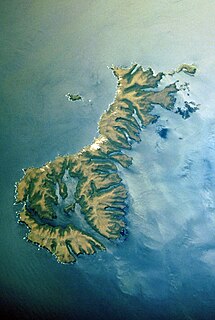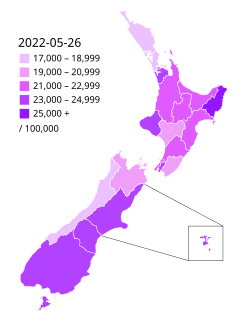
Sir Edmund Percival Hillary was a New Zealand mountaineer, explorer, and philanthropist. On 29 May 1953, Hillary and Sherpa mountaineer Tenzing Norgay became the first climbers confirmed to have reached the summit of Mount Everest. They were part of the ninth British expedition to Everest, led by John Hunt. From 1985 to 1988 he served as New Zealand's High Commissioner to India and Bangladesh and concurrently as Ambassador to Nepal.

The Auckland Islands are an archipelago of New Zealand, lying 465 kilometres (290 mi) south of the South Island. The main Auckland Island, occupying 510 km2 (200 sq mi), is surrounded by smaller Adams Island, Enderby Island, Disappointment Island, Ewing Island, Rose Island, Dundas Island, and Green Island, with a combined area of 626 km2 (240 sq mi). The islands have no permanent human inhabitants.

Auckland Airport is the largest and busiest airport in New Zealand, with over 21 million passengers in the year ended March 2019. The airport is located near Mangere, a residential suburb, and Airport Oaks, a service hub suburb 21 kilometres (13 mi) south of the Auckland city centre. It is both a domestic and international hub for Air New Zealand, and the New Zealand hub of Jetstar Airways.

The University of Auckland is a public research university based in Auckland, New Zealand. It is the highest ranked New Zealand university in the QS World University Rankings and Shanghai Jiao Tong Academic Ranking of World Universities. The institution was established in 1883 as a constituent college of the University of New Zealand. Originally it was housed in a disused courthouse. Today, the University of Auckland is New Zealand's largest university by enrolment, hosting about 40,000 students on five Auckland campuses. The City Campus, in central Auckland, has the bulk of the students and faculties. There are eight faculties, including a law school, as well as three research institutes associated with the university.

Mount Smart Stadium is located in Auckland, New Zealand. It is the home ground of National Rugby League team, the New Zealand Warriors. Built within the quarried remnants of the Rarotonga / Mount Smart volcanic cone, it is located 10 kilometres south of the city centre, in the suburb of Penrose.

The Auckland Region is one of the sixteen regions of New Zealand, named for the city of Auckland, the country's largest urban area. The region encompasses the Auckland metropolitan area, smaller towns, rural areas, and the islands of the Hauraki Gulf. Containing 34 percent of the nation's residents, it has by far the largest population and economy of any region of New Zealand, but the second-smallest land area.

Eden Park is New Zealand's largest sports stadium. Located in central Auckland, New Zealand's largest city, it is three kilometres southwest of the CBD, on the boundary between the suburbs of Mount Eden and Kingsland. Although used primarily for rugby union in winter and cricket in summer, it has hosted rugby league and association football matches. In 2011 it hosted pool games, two quarter-finals, both semi-finals and the final of 2011 Rugby World Cup. In doing so it became the first stadium in the world to host two Rugby World Cup Finals, having held the inaugural final in 1987. It was a venue for the 2015 Cricket World Cup, which was jointly hosted by Australia and New Zealand.

Auckland City was a city in the Auckland urban area, covering the central isthmus and most of the islands of the Hauraki Gulf. It included the Auckland CBD – a major financial and commercial centre – and a number of suburbs.
The Auckland War Memorial Museum Tāmaki Paenga Hira is one of New Zealand's most important museums and war memorials. Its collections concentrate on New Zealand history, natural history, and military history. The present museum building, which is considered one of the most iconic in Auckland, was constructed in the 1920s in the neo-classicist style, and sits on a grassed plinth in the Auckland Domain, a large public park close to the Auckland CBD.

Auckland City Football Club is a New Zealand professional football club based in the suburb of Sandringham in Auckland, New Zealand. They currently compete in the ISPS Handa Premiership, the highest level of domestic football in New Zealand. Auckland City have established themselves as a major force in both New Zealand and Oceania, having won eight league titles and nine OFC Champions League titles since their foundation.

Auckland Art Gallery Toi o Tāmaki is the principal public gallery in Auckland, New Zealand, and has the most extensive collection of national and international art in New Zealand. It frequently hosts travelling international exhibitions.

The Auckland Aces represent the Auckland region and are one of six New Zealand domestic first class cricket teams. Governed by the Auckland Cricket Association they are the most successful side having won 28 Plunket Shield titles, ten Ford Trophy championships and the Super Smash four times. The side currently play their home games at Eden Park Outer Oval.
Arthur William Baden Powell was a New Zealand malacologist, naturalist and palaeontologist, a major influence in the study and classification of New Zealand molluscs through much of the 20th century. He was known to his friends and family by his third name, "Baden".

The Auckland Star was an evening daily newspaper published in Auckland, New Zealand, from 24 March 1870 to 16 August 1991. Survived by its Sunday edition, the Sunday Star, part of its name endures in The Sunday Star-Times, created in the 1994 merger of the Dominion Sunday Times and the Sunday Star.
The Auckland rugby league team is the team which traditionally represents all of the clubs which play in the Auckland Rugby League competition. As well as a senior men's team there are also Auckland representative teams throughout the various age groups such as under 15s, under 17s, under 19s and under 21s.
Barry Selwyn Gustafson is a New Zealand political scientist and historian, and a leading political biographer. He served for nearly four decades as professor of political studies at the University of Auckland, and as Acting Director of the New Zealand Asia Institute from 2004 to 2006. He has contested various general elections, first for the Labour Party and later for the National Party, coming second each time.

Auckland is a large metropolitan city in the North Island of New Zealand. The most populous urban area in the country, Auckland has an urban population of about 1,470,100. It is located in the Auckland Region—the area governed by Auckland Council—which includes outlying rural areas and the islands of the Hauraki Gulf, resulting in a total population of 1,717,500. Auckland is a diverse, multicultural and cosmopolitan city. While Europeans continue to make up the plurality of Auckland's population, the city has developed an increasingly 'Eurasian' identity in the twenty-first century, with Asians accounting for 31% of the city's population in 2018. Auckland is also home to the largest Polynesian population in the world. The Māori-language name for Auckland is Tāmaki Makaurau, meaning "Tāmaki desired by many", in reference to the desirability of its natural resources and geography. The word Tāmaki itself generally means an omen or portent.

Auckland Council is the local government council for the Auckland Region in New Zealand. It is a territorial authority that has the responsibilities, duties and powers of a regional council and so is a unitary authority, according to the Local Government Act 2009, which established the Council. The governing body consists of a mayor and 20 councillors, elected from 13 wards. There are also 149 members of 21 local boards who make decisions on matters local to their communities. It is the largest council in Oceania, with a $3 billion annual budget, $29 billion of ratepayer equity, and 9,870 full-time staff as of 30 June 2016. The council began operating on 1 November 2010, combining the functions of the previous regional council and the region's seven city and district councils into one "super council" or "super city".

The COVID-19 pandemic in New Zealand is part of the ongoing pandemic of coronavirus disease 2019 caused by severe acute respiratory syndrome coronavirus 2. The first case of the disease in New Zealand was reported on 28 February 2020. As of 3 March 2021, the country has had a total of 2,384 cases. 26 people have died from the virus, with cases recorded in all twenty district health board (DHB) areas. The pandemic peaked in early April 2020, with 89 new cases recorded per day and 929 active cases.
There have been several COVID-19 anti-lockdown protests in New Zealand held in 2020, where people protested the government's response to the COVID-19 pandemic in New Zealand, in particular the lockdown measures in place in March–May and August 2020.














